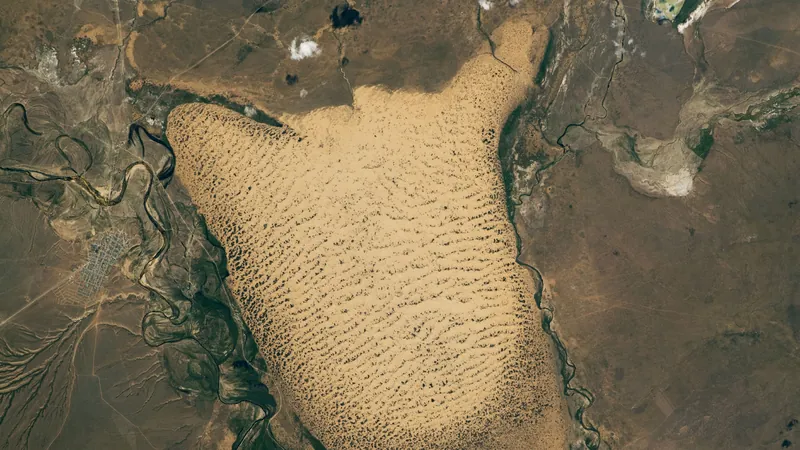
Unlocking the Mysteries of Ice Ages: UConn Researchers Discover Key Clues
2025-08-26
Author: Mei
A Deep Dive into Ice Ages
For decades, scientists have been stumped by the question: what triggers the drop in atmospheric CO2 during ice ages? Now, researchers from the University of Connecticut (UConn) are tackling this mystery head-on. Led by Ph.D. student Monica Garity, the team has published groundbreaking findings in The Proceedings of the National Academy of Sciences (PNAS) that shine a new light on the processes behind ice age inception.
The Ocean's Role in Carbon Storage
The ocean plays a crucial role in balancing Earth's carbon, serving as both a carbon sink and a source. To unravel past changes in atmospheric CO2, Garity and her colleagues examined oceanic carbon storage over a staggering 150,000-year span, focusing on how massive continental ice sheets expanded and receded during past ice ages.
From Inception to Termination: A Focus on Feedbacks
Unlike previous studies that primarily addressed the concluding phases of ice ages, Garity’s research digs into the beginning stages known as inception. "We’re investigating whether consistent feedback mechanisms operate during both glacial inception and termination," she explained. Various feedbacks likely contribute to lowered CO2 levels, yet pinpointing them remains a formidable challenge.
Unearthing Clues from the Deep Sea
Utilizing sediment cores collected from the remote Brazil Margin of the Atlantic Ocean, the research team has access to invaluable records of ancient ocean chemistry. Dating back to the 1990s, these cores contain tiny shells of protists known as foraminifera, which capture chemical signatures from their time. By analyzing these microscopic marine organisms for key isotopes and metal ratios, Garity's team can reconstruct historical carbonate ion concentrations connected to carbon content.
A Labor of Love: Cleaning and Analyzing Samples
Extracting usable samples from these cores involves meticulous work. "We freeze-dry the sediment and wash it through fine sieves to isolate the foraminifera," Garity detailed. "It takes a lot of effort standing over the sink to clean out the mud, but it’s thrilling to watch the diversity of foraminifera reveal historical changes in ocean chemistry."
Revealing Historical Ocean Acidification
The project not only illuminates past changes but also offers insights into current ocean acidification trends. As carbon storage in the ocean increases, acidity rises, potentially dissolving the delicate foraminifera shells. Garity noted an exciting trend from 115,000 years ago, where a decline in carbonate ions marked the onset of glacial inception and significant carbon storage in the Atlantic.
Implications for Today's Climate Challenge
These findings have major implications for our contemporary climate crisis. Increased atmospheric CO2 leads to more carbon entering the ocean, but the rapid pace at which these changes occur today far exceeds historical rates. Garity emphasizes the importance of this research: "Understanding past climate patterns can help us predict future shifts more accurately and adds another piece to the long-standing puzzle of ice ages."
Future Directions: Expanding the Research
Looking ahead, Garity’s team aims to gather more carbonate ion records from various ocean locations to corroborate their findings. Collaboration with fellow researchers and undergraduate students has been instrumental in advancing this project, setting the stage for future discoveries.
Joining Forces for a Common Goal
As Garity approaches the completion of her Ph.D., she looks forward to continuing this vital research, along with her colleague Hope Jerris, who aspires to pursue a similar path. Together, they champion the pursuit of climate knowledge: "The more we understand our climate history, the better we can navigate the path to a sustainable future."




 Brasil (PT)
Brasil (PT)
 Canada (EN)
Canada (EN)
 Chile (ES)
Chile (ES)
 Česko (CS)
Česko (CS)
 대한민국 (KO)
대한민국 (KO)
 España (ES)
España (ES)
 France (FR)
France (FR)
 Hong Kong (EN)
Hong Kong (EN)
 Italia (IT)
Italia (IT)
 日本 (JA)
日本 (JA)
 Magyarország (HU)
Magyarország (HU)
 Norge (NO)
Norge (NO)
 Polska (PL)
Polska (PL)
 Schweiz (DE)
Schweiz (DE)
 Singapore (EN)
Singapore (EN)
 Sverige (SV)
Sverige (SV)
 Suomi (FI)
Suomi (FI)
 Türkiye (TR)
Türkiye (TR)
 الإمارات العربية المتحدة (AR)
الإمارات العربية المتحدة (AR)